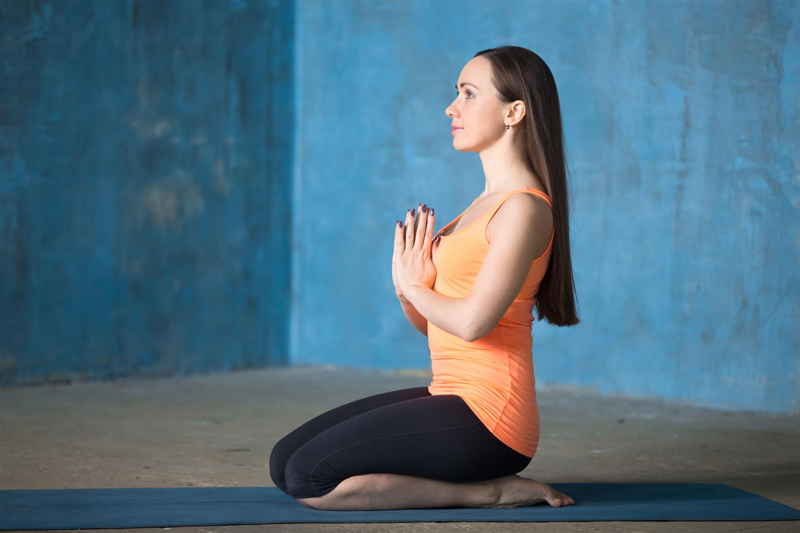
How to do Child’s pose in yoga
22nd June 2018
Can Yoga Improve Communication?
22nd June 2018How to do Vajrasana pose in yoga

The Vajrasana pose takes its names from the Sanskrit word Vajra. Vajra means diamond or thunderbolt, and asana means pose. It is also known as Adamantine Pose. Some know it simply as the kneeling pose.
The belief is that if you undertake this pose during breathing exercises your body will take on the strength of a diamond. This is not only strength of the body – though you will become physically hard to move once the pose is mastered. It promotes strength of the mind – as you will take up this pose when undertaking meditation – developing more discipline than ever to steady and focus the mind.
It is the pose traditional Japanese take up when participating in the tea ceremony.
How to position your body
Getting into Vajrasana is easy. Staying in the pose is a different matter. The good news is that you can do this pose after you have eaten – in fact, the only yoga pose you should do after food, to help with the digestion of your meal.
This is a kneeling pose. Therefore, you need to sit on your knees, with your bottom on your feet. You should sit with a straight posture, with an upright spine. The top of your feet should be flat on the floor and your soles turned upwards and supporting your glutes, or your butt cheeks.
The tip for holding this pose is to focus on your breathing. To begin with aim to hold the pose for 30 seconds but you should soon be working towards 5 and 10 minutes and then beyond.
At first you will notice pain in the legs relatively quickly. When discomfort turns to pain you should move out of the pose and stretch out your legs, giving your legs a massage before trying the pose again once recovered. You should work to better the pose by lengthening the duration. This will happen with time due to flexibility in the quads and a strengthening of the lower back.
Benefits of the Vajrasana pose
This is a pose that is good for the digestion and liver function. With better digestion comes a reduction in your chances of ulcers in the stomach.
It is also great for relieving sciatica and nerve issues. By restricting blood to the lower part of the body, you are increasing the flow to your pelvic area and stomach. Therefore, it is a positive influence on bowel movement and in reducing the impact of indigestion. It also helps with the absorption of nutrients from food.
You can undertake the pose whilst menstruating – and it is thought that the pose can help relieve some of the pain associated with periods, as it relieves pressure in the pelvic area.
The pose is also great for strengthening the lower back and it gives your quads an all-important stretch.
You will feel this pose in your thighs, knees, hip, back and ankles, where you will begin to attain greater flexibility.
However, ultimately, you are practising this pose to master a stillness of the mind and the body. Sitting meditating in this kneeling pose will promote concentration and a calm awareness – eventually.

Cautions
It is important to be aware of the potential for leg injury, particularly injury to the knee. If you are pregnant make sure you keep your legs slightly apart to avoid undue pressure on the abdomen – but be aware that the pose is amazing for reducing labour pains! People with ailments of the spinal column might want to avoid this pose or attempt the pose under supervision.
Instructions
- Ensure that the crown of the head points towards the sky.
- Your gaze should be focused on a single point in front of you, with your chin parallel to the floor.
- Make sure you lift and open the chest, as this is a heart opening pose.
- You should make sure the big toes of your feet are touching and your knees are together.
- It is possible for this to be a relatively passive pose. To add strength to the pose you should engage the core muscles, so that you fully straighten the spine.
- Now, focus on your breathing.
- Aim for 5 – 10 minutes, after some practice.
Modifications and Variations
Taking Vajrasana to the next level might seem impossible, such is the simplicity of the pose. However, the aim is to hold the pose during meditation without discomfort. Expert yogis would hope to hold the pose up to 20 minutes, whilst entirely focused on breathing practices. This is the pose that you will move to take up whilst undertaking breathing exercises such as Pranayama, Kapalabhati, and Anulon Vilom.
The advanced variation of this pose is the Supta Vajrasana. Once in the pose you would bend backward and place your forearms, and elbows, on the floor. Arch your spine and neck until the crown of your head is touching the floor. This is a significant progression from basic Vajrasana and should be first done with supervision. However, the benefits increase – as it helps with strength of muscles in the neck, back and chest. It can help expand the chest and therefore ease lung problems.
Before you try Supta Vajrasana master the basic pose of Vajrasana and feel comfortable in the position to meditate for up to 20 minutes and maybe beyond.
Perfecting Vajrasana
Make sure, once the pose is perfected, that your attention turns to your breathing. You should be fully aware of your breath and observe each inhalation and exhalation. It is sometimes preferable to close your eyes to fully calm your mind. One of the greatest challenges is to steady the mind – probably more than mastering any pain in the legs.

